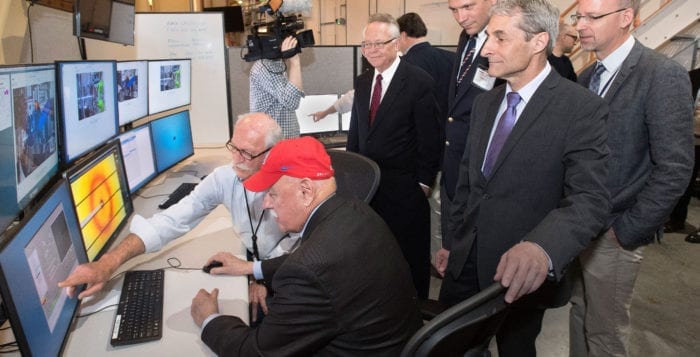New York commits $15 million for BNL microscope

Thanks to the persistent support of state Sen. Ken LaValle (R-Port Jefferson), Brookhaven National Laboratory secured $15 million from New York State to add a state-of-the-art microscope that could contribute to advances in basic science and medicine.
The national laboratory will purchase a new cryo-electron microscope and will use the funds to create a building attached to its National Synchrotron Light Source II.
“Cryo-electron microscopy is an advanced imaging technology that will significantly accelerate scientists’ understanding of molecular structures and processes generally, including many impacts in understanding disease and in aiding drug discovery,” Doon Gibbs, the laboratory director of BNL, said in an email.
BNL will use the funds to purchase the first of what they hope will be four such new microscopes. The lab is finalizing a bid, which is due by June 30 for funds from the National Institutes of Health for three additional microscopes.
“There is an exponentially increasing demand for the type of bio-structural information that such machines provide, and so we are competing to become an East Coast based national facility to serve this rapidly growing community,” James Misewich, the associate director for energy and photon sciences at BNL said in an email.
Having a suite of microscopes would enable BNL to have a spectrum of capabilities to serve the needs of its scientists and of researchers from around the world who flock to the Upton-based lab to conduct their research.
The new facility will create jobs associated with running the cryo-EM, Misewich said. If BNL wins the NIH proposal to become a national cryo-EM facility, it would also employ additional scientists, engineers, technicians and administrators to run the user program.
Misewich said he hopes scientists at nearby Stony Brook University and Cold Spring Harbor Laboratory will benefit from the opportunity to use a combination of its X-ray and electron microscope probes.
Senior members of the BNL team credit LaValle for helping to secure the funds.
“The $15 million in New York State funding is the culmination of a two-year effort led by the senator to bring a cryo-EM to Brookhaven and jump-start this important effort,” Gibbs said.
LaValle suggested that the funds were well worth the investment.
“It is critically important for government to embrace and support the work of the organizations that make life-altering discoveries and better our lives, health and environment,” LaValle said in an email. “This investment will further establish world-leading prominence in the field of medical research, and position the region for additional major investments by the National Institutes of Health and the U.S. Department of Energy.”
Misewich envisions configuring one of the microscopes to allow for electron tomography, which will generate three-dimensional images of cells.
“The approach will be complementary to the X-ray imaging work we can undertake with the NSLS-II beamlines,” Misewich said.
Gibbs explained that the cryo-EM is complementary to X-ray crystallography, which is the traditional method for determining structures, which scientists already do at BNL.
“Few prescription drugs have been approved by the [Food and Drug Administration] for use in the U.S. in the last 20 years without a crystallographic study of their structure by X-rays,” Gibbs continued.
Misewich expects the new microscope could lead to new methods of detection, diagnosis and treatment for diseases like cancer or for medical challenges like antibiotic resistance.
Combining the technological tools of the new cryo-EM with the insights from the NSLS II and the nine-year-old Center for Functional Nanomaterials will enable researchers to “provide much more rapid bio-structure determination in response to needs like the ability to rapidly characterize a virus,” Misewich said.
LaValle sited this effort as a part of his ongoing commitment to build Long Island’s new high-tech economy.
The combination of BNL, SBU and CSHL “will provide a significant boost to the competitiveness of the biosciences and biotechnology communities across Long Island,” LaValle said.






